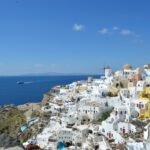Marrakech is located in southwestern Morocco, nestled at the foothills of the Atlas Mountains. With a population of approximately 1.05 million, it is the fourth largest city in Morocco and one of the country’s four imperial cities, rich in history and cultural heritage.
The name “Marrakech” has several origin stories, one of which traces back to the Berber language, meaning “Land of God.” This area has been inhabited by Berber farmers since the Neolithic period, and the city was founded in 1070, becoming the capital of the Almoravid Empire. Throughout history, Marrakech served as the capital of Morocco during various periods, establishing a close connection between the city and the country itself. In fact, in many languages—including Persian, Urdu, and some South Asian tongues—Morocco is still referred to as Marrakech to this day.

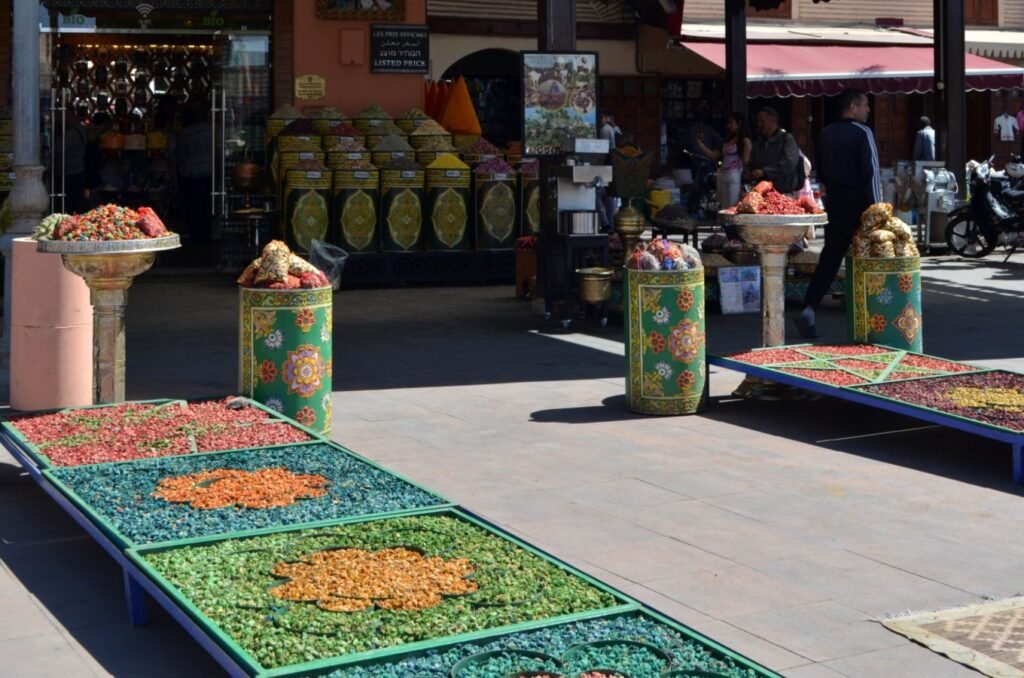
The red city walls of Marrakech, along with various buildings later constructed from red sandstone, earned the city its nickname, “The Red City.” Thanks to its vibrant history, rich cultural heritage, and year-round sunshine, Marrakech has become one of Morocco’s most famous tourist destinations. It particularly attracts large numbers of European visitors, some of whom have even decided to settle there.
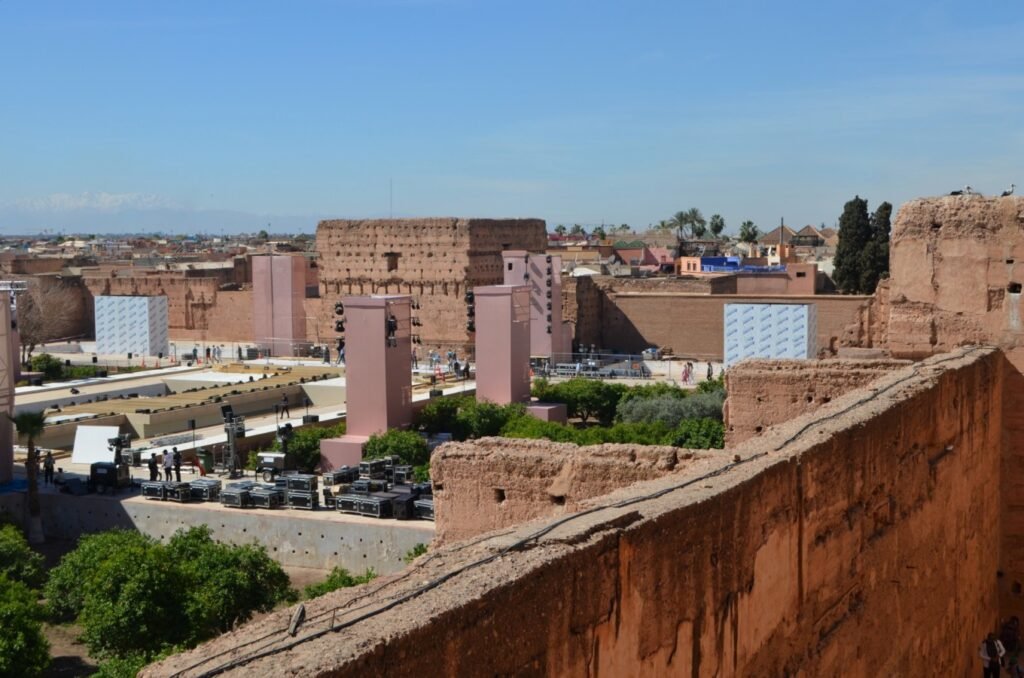

The Badi Palace, meaning “The Palace of Wonders” or “The Incomparable Palace” in Arabic, was constructed under the Saadian dynasty by Sultan Ahmad al-Mansur after his accession in 1578, marking the peak of Saadian power. Prior to this, Marrakech rulers mainly resided in the fortress built by the Almohad dynasty during the 12th and 13th centuries. Alongside military dominance, Sultan al-Mansur strengthened control over the sugar trade. At the time, Morocco was a key sugar exporter to Europe, along with silk, copper, and leather.
The construction of the Badi Palace was an immense project, attracting artisans from various European regions, and decorative materials were imported from countries such as Italy and Mali. Records suggest that the building and embellishment of the palace took at least 15 years to complete. The palace included private residences for the sultan and his family, baths, a private mosque, a mint, and several gardens.


The Badi Palace was used by Sultan Ahmad al-Mansur to receive guests, serving as a showcase of the Saadian dynasty’s wealth and power, reflecting the splendor of its time. It is said that the palace was constructed using the most expensive materials available, including gold, onyx, and Italian marble. The walls were adorned with costly plasterwork and intricate inscriptions, the floors paved with marble and mosaic tiles, while the ceilings and capitals were gilded, achieving an unparalleled level of opulence.
However, after the death of al-Mansur in 1603, the palace lost its significance. With the decline of the Saadian dynasty, the once-magnificent Badi Palace eventually fell into ruin. A century later, the palace’s materials—particularly its marble—were stripped and repurposed for other buildings in Morocco, sealing the fate of this once-glorious architectural masterpiece.

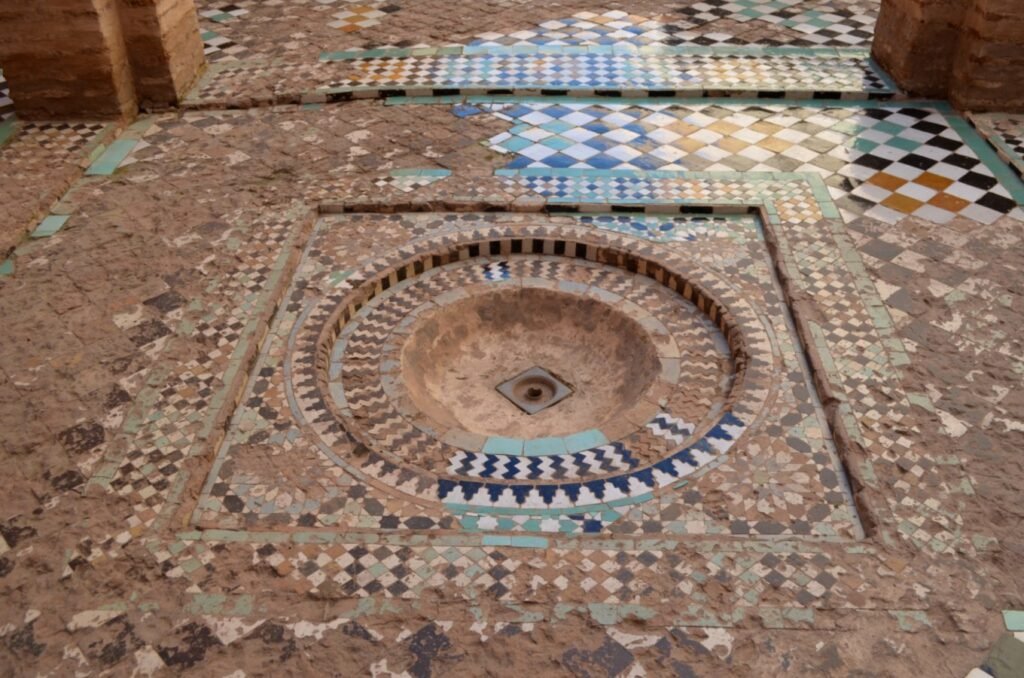
Today, although the Badi Palace stands in ruins, it remains one of Marrakesh’s most significant tourist attractions, also housing the minbar from the Koutoubia Mosque. One surprising sight atop the palace’s remains is the presence of large birds and their impressive nests—these are storks, which migrate annually between Europe and Africa, following the changing seasons. In Marrakesh, storks are regarded as sacred animals. The Berber people once believed that storks were humans transformed, earning them special reverence and care. Their presence adds a unique touch of vitality and life to the ruins of the Badi Palace.

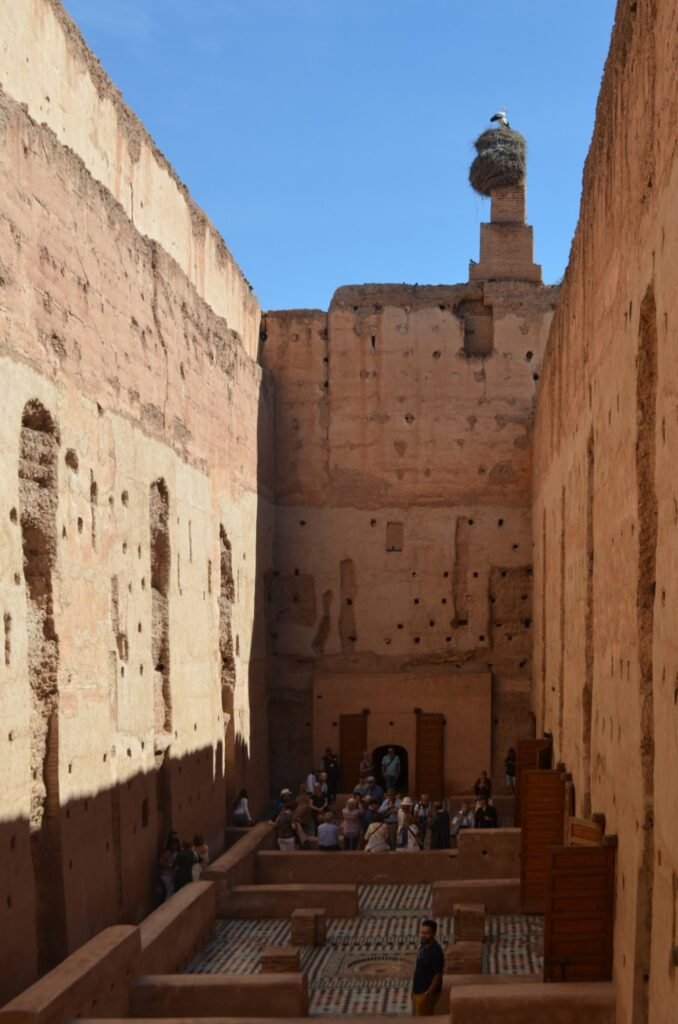
Bahia Palace
In addition to the Badi Palace, another renowned palace in Marrakesh is the Bahia Palace. Though not the oldest structure, it is considered one of the most beautiful landmarks in Marrakesh and remains one of Morocco’s most visited tourist attractions.
The Bahia Palace is not a royal palace in the strict sense but rather a luxurious residence. It was first commissioned by Si Musa in 1866, a man of significant influence who rose from a background as a Black slave to become the grand vizier of Sultan Mohammed IV. “Bahia” means “brilliance and wisdom” in Arabic, and it is said to be the name of Musa’s most beloved wife. The palace’s design was overseen by Morocco’s renowned architect Mohamed Ben Makki, with artisans from across the country contributing their craftsmanship.
Si Musa’s son, Ba Ahmed, who later became Morocco’s regent, further expanded the Bahia Palace between 1894 and 1900. It became his residence, housing his four wives and 24 concubines. After Ba Ahmed’s death, the palace went through a series of transitions. In 1912, it served as the residence of the French Resident General during Morocco’s French Protectorate era. Following Morocco’s independence in 1956, the Bahia Palace was used as a royal residence by King Mohammed V. Eventually, it was handed over to the Ministry of Culture and transformed into a tourist site open to visitors from around the world.
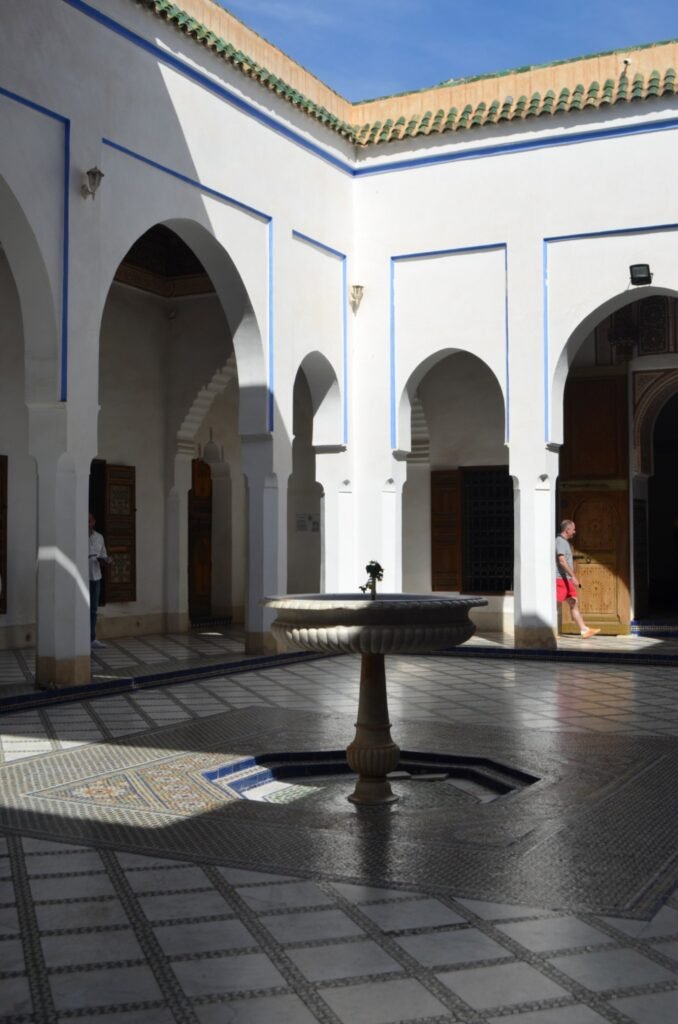

The Bahia Palace contains approximately 150 rooms, and the various stages of expansion have given it a labyrinth-like layout. Among its most striking features are its lush gardens and courtyards, filled with orange trees and jasmine flowers, whose subtle fragrance wafts through the air under the bright sunshine, creating a captivating atmosphere. Crystal-clear fountains, intricately carved plaster decorations, and floors and walls covered with exquisite mosaic tiles evoke a distinct Moroccan charm.
The rooms surrounding the courtyards are equally refined, reflecting the grandeur of Ba Ahmed’s vision. It is said that he spared no expense, sourcing precious materials for this residence from both local and international suppliers. Cedarwood was brought from the nearby Atlas Mountains, marble from Meknes and Italy, and tiles from Tetouan, achieving an unparalleled level of luxury. The Bahia Palace is also recognized as the first building in North Africa to use stained glass as a decorative element, showcasing Morocco’s openness to and incorporation of European architectural styles at the time.
The Bahia Palace fully embodies the delicacy and elegance of traditional Moroccan architecture, while subtly incorporating elements of European design. Having withstood the test of time, the palace has been well-preserved and carefully restored, making it a site worth savoring. It stands as a must-visit destination for anyone traveling to Marrakech.
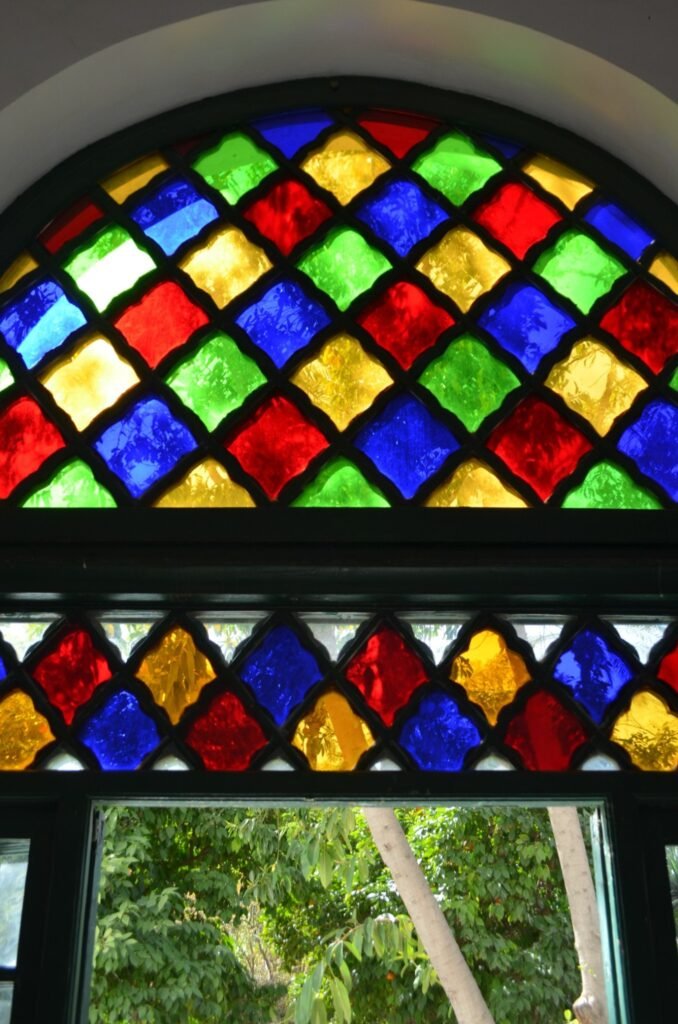

The Bahia Palace fully embodies the delicacy and elegance of traditional Moroccan architecture, while subtly incorporating elements of European design. Having withstood the test of time, the palace has been well-preserved and carefully restored, making it a site worth savoring. It stands as a must-visit destination for anyone traveling to Marrakech.
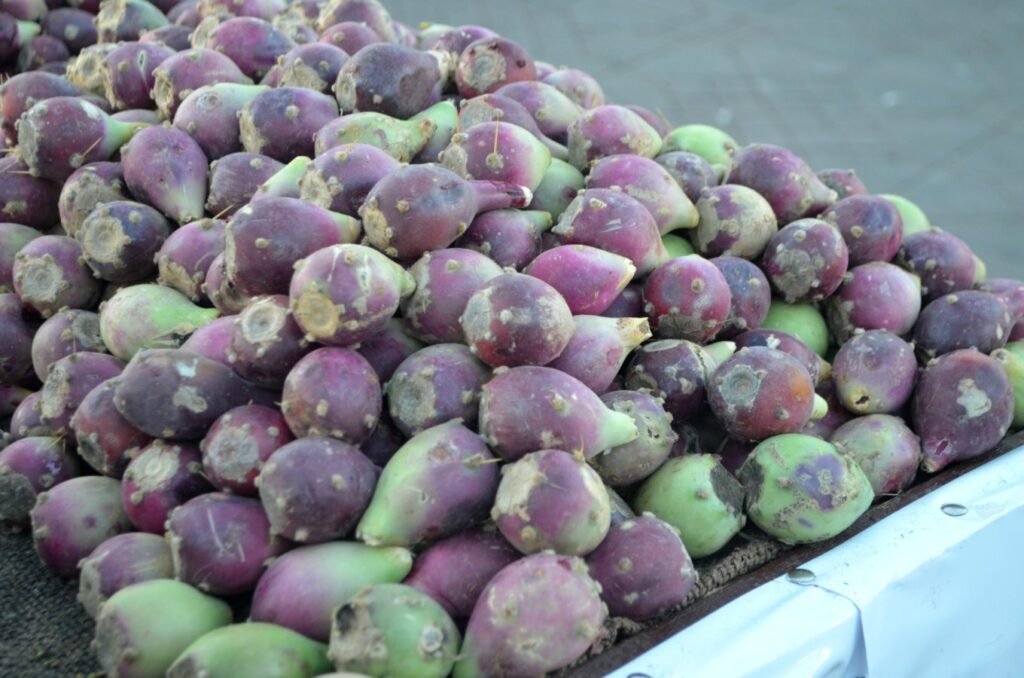

Jemaa el-Fna Square covers a vast area, though it remains relatively quiet during the day. Most of the activity revolves around stalls selling freshly squeezed juices, dried fruits, and spices, alongside mysterious snake charmers and monkey trainers attracting passersby. Juice vendors line up in neat rows, with lively and cheerful attendants enthusiastically inviting customers to stop by and even take photos with them.
One of the more intriguing sights on the square is the abundance of stalls selling prickly pear fruits. Most of these vendors operate from carts stacked with the fruits. After selecting your prickly pear, it’s best to let the vendor peel it for you, making it easy to enjoy the soft, sweet flesh inside without the hassle.

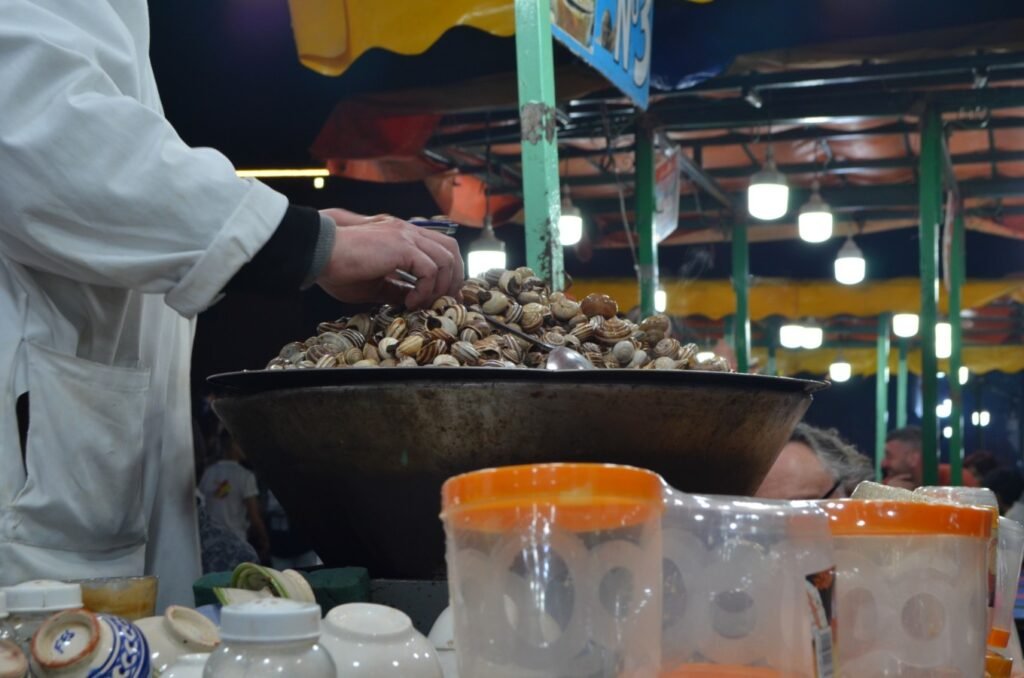
As evening approaches and night falls, Jemaa el-Fna Square transforms into an entirely different scene. Crowds begin to gather from all directions, and the square grows increasingly lively. For a panoramic view of the bustling square, the best option is to visit one of the nearby cafés or restaurants with terraces, allowing you to dine and drink while gazing out over the lively scene below.
With the night air bringing a refreshing coolness, the square fills with smoke and aromas as food stalls kick off their busiest time of the day. A vendor tirelessly stirs snails in a pan, quickly serving them in bowls and adding a ladle of broth. Locals, accustomed to this delicacy, eat with focus and ease, finishing with a sip of warm broth before leaving satisfied.
The dinner stalls, eager to attract customers, present a feast of roasted lamb, grilled beef, and dishes like sheep’s head and brain, all laid out in a bold, down-to-earth manner. Other stalls offer cinnamon tea and traditional local desserts, providing a complete experience for those looking to satisfy their appetite and indulge in sweet treats after their meal.


In addition to the variety of foods, the square offers a myriad of attractions, including live music, singing and dancing, storytelling, magic shows, henna painting, number games, and fishing games, with each stall striving to create its own small stage amidst the bustling crowd. The aromas of food, the steam and smoke from cooking, the constant flow of people, and the vibrant array of stalls make for a dazzling sight. This lively and chaotic atmosphere reflects the unique charm of this ancient, sleepless square, a place where tradition and vitality have coexisted for centuries.


Art Garden
Marrakech, with its distinct Moroccan charm, has captivated numerous renowned artists and art enthusiasts seeking inspiration. These creative souls have infused the ancient and beautiful city with new vitality and aesthetic appeal. One of the most famous examples is the Majorelle Garden. In 1917, French artist Jacques Majorelle arrived in the Red City of Marrakech and was deeply enchanted by its allure. He decided to settle there and devoted nearly 40 years to creating his garden. Later, the iconic fashion designer Yves Saint Laurent purchased the garden and lovingly maintained it. After his passing, Saint Laurent’s ashes were scattered in the garden. Adjacent to the Majorelle Garden is the celebrated YSL Museum, drawing visitors from around the world.
In addition to the Majorelle Garden, Marrakech boasts many other gardens, each competing in beauty and charm.
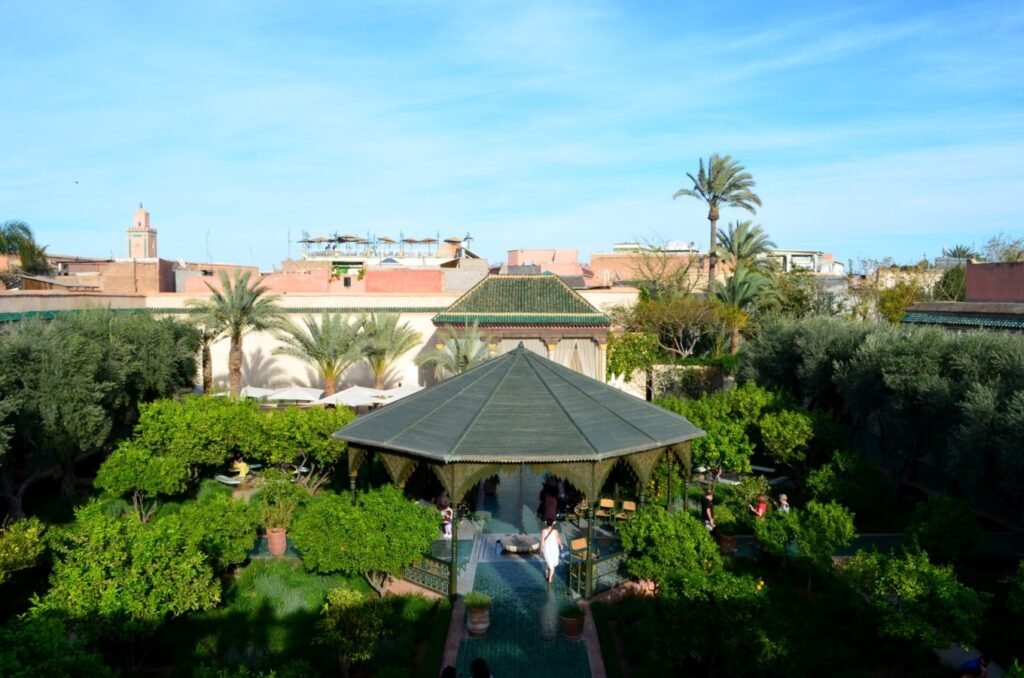
In the bustling streets of the old city lies a small and charming “Secret Garden.” It is said that this site was once the original palace of a sultan over four centuries ago, and its fate fluctuated with the rise and fall of dynasties. In 2008, a restoration project began, and in 2016, the Secret Garden opened to the public for the first time.
The garden is divided into two sections: one is an exotic tropical garden, while the other exudes a local charm, designed as an Islamic garden, carefully replicating the elegance of the palace and garden from its heyday. The park is home to over 80 species of plants, interspersed with exquisite pavilions, ingeniously designed fountains, and wooden benches for relaxation. The Secret Garden serves as a tranquil oasis amidst the bustling old city, offering a refreshing and serene escape.
One particularly noteworthy feature is the garden’s tower. Although not very tall, it stands as one of the highest points in Marrakech, apart from the mosques. From the top, visitors can enjoy a panoramic view of the city’s layered homes, distant snow-capped mountains, and palm trees, capturing the essence of Marrakech in one breathtaking scene.
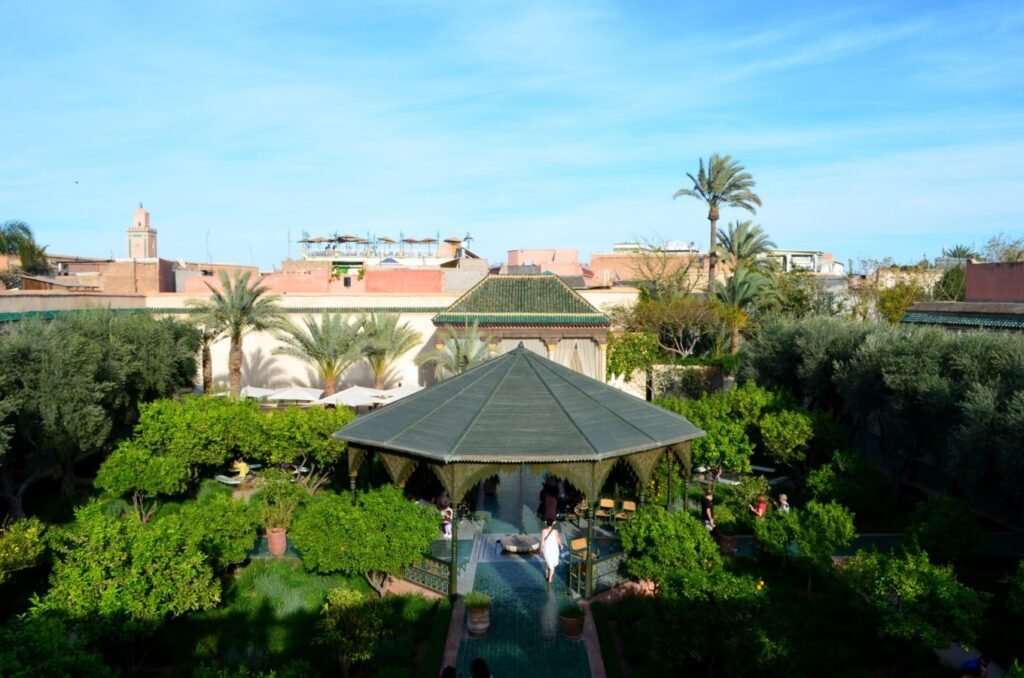

Marrakech’s airport is named Menara Airport, located near the famous Menara Gardens. The Menara Gardens hold significant historical value as a public park and orchard. The garden comprises a large central reservoir, a pavilion, and a vast orchard nearby, stretching about 1,200 meters in length and 800 meters in width. Since 1985, it has been recognized as a UNESCO World Heritage site.
The Menara Gardens boast a long history, established around 1130 by Abd al-Mu’min, the founder of the Almohad dynasty in North Africa. Over the centuries, the garden witnessed the rise and fall of dynasties and was eventually restored and enhanced by Sultan Abderrahmane and his son Mohammed IV in the 19th century. In 1870, the pavilion we see today was built.
Though the pavilion’s decoration is relatively modest, with geometric patterns and calligraphic ornaments around the entrance and windows, it holds a delightful surprise. Despite the scorching heat outside, stepping into the pavilion offers a cooling breeze, leaving visitors refreshed. Gazing at the shimmering water surface eliminates the need for any artificial cooling methods.
The reservoir was originally constructed to support agricultural production and later served as a recreational space for the sultans. Olive trees dominate the nearby orchard, with the reservoir storing ample water for irrigation. The combination of the pavilion, reservoir, lush greenery, and the snow-capped Atlas Mountains in the distance creates a breathtaking scene, resembling a vibrant painting. This picturesque setting has become one of Marrakech’s most iconic landmarks.

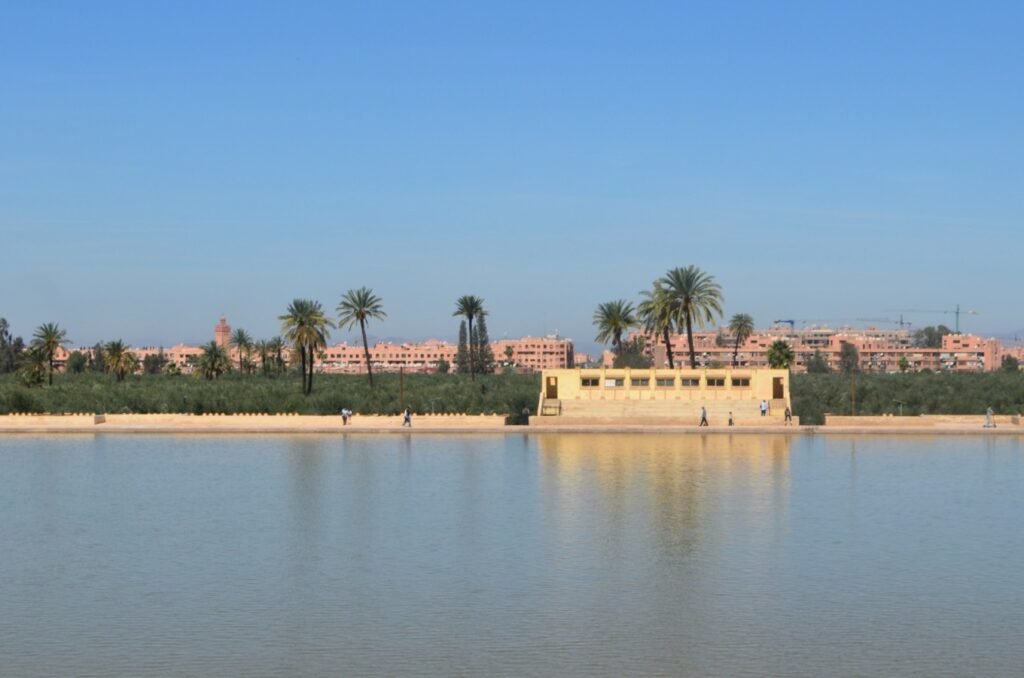
Koutoubia Mosque
As one of the magical cities of North Africa reminiscent of One Thousand and One Nights, Marrakech offers much more than meets the eye. The Koutoubia Mosque is located in the southwestern part of the old city, approximately 200 meters from Jemaa el-Fnaa Square. It was commissioned in 1147 by Abd al-Mu’min, the ruler who conquered the city. What stands today is actually the second mosque, constructed around 1158, as the first mosque was likely abandoned due to misalignment issues, with its ruins still visible today.
The name “Koutoubia” derives from the Arabic word for “bookseller,” possibly referring to the merchants who sold books in the nearby open market at that time. The Koutoubia Mosque is considered a quintessential example of Almohad architecture and Moroccan mosque design. Its minaret, standing 77 meters tall with an 8-meter pinnacle, showcases the Almohad style, adorned with various arched patterns and progressively smaller gilded copper spheres toward the top. The design is closely related to the Giralda Tower in Seville and the Hassan Tower in Rabat.
Due to its significant height and protective regulations, the minaret remains the tallest building in Marrakech to this day. Visible from up to 29 kilometers away, the tower serves as a prominent symbol and landmark of the city.


Old Medina
The Koutoubia Mosque is located within the old city, known as the Medina, which is a defining feature of many North African cities. As a city with a millennium of history, Marrakech’s Medina is particularly vast. Beyond the Majorelle and Menara Gardens, nearly all of Marrakech’s iconic landmarks are situated within the Medina. Established by the Almoravid dynasty between 1070 and 1072, the Medina became the capital and economic, political, and cultural center of this nomadic empire. Over the next two centuries, the city continued to develop, and the 12th-century walls and the palm grove to the east still remain today.
Wandering through the souks of Marrakech’s Medina, you’ll encounter a labyrinth of winding alleys filled with countless stalls. Shops selling handmade crafts, spices, dried fruits, local specialties, and jewelry seem to stretch endlessly. While strolling through these narrow, colorful alleys, visitors are often approached by friendly vendors eager to engage. Even with electronic navigation, it can sometimes be necessary to ask locals for directions.
In these vibrant streets, unexpected discoveries are common. For example, one unassuming shop displaying a pot filled with fine sand offers a unique experience: coffee brewed in sand. The shopkeeper adds coffee grounds and spices to water in a cup, then stirs the cup continuously in the hot sand. The coffee quickly forms a layer of foam and fragrant oils, leaving first-time observers amazed at this novel brewing method. While the shop might not appear remarkable at first glance, it offers a rooftop terrace where guests can sip their sand-brewed coffee while enjoying panoramic views of Marrakech and embracing a leisurely, relaxed atmosphere.
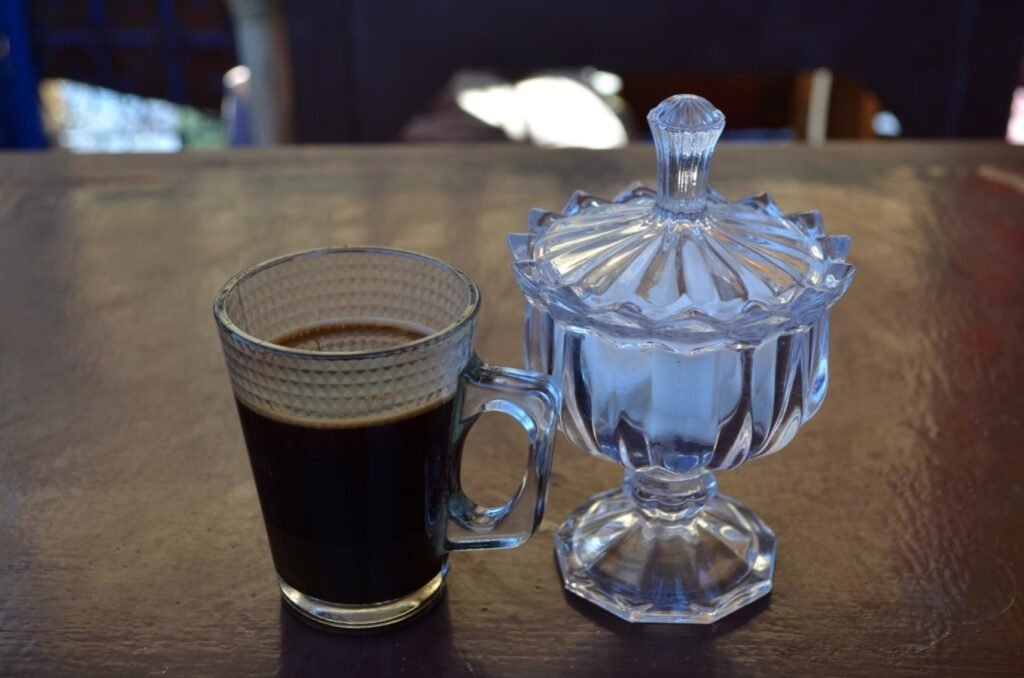
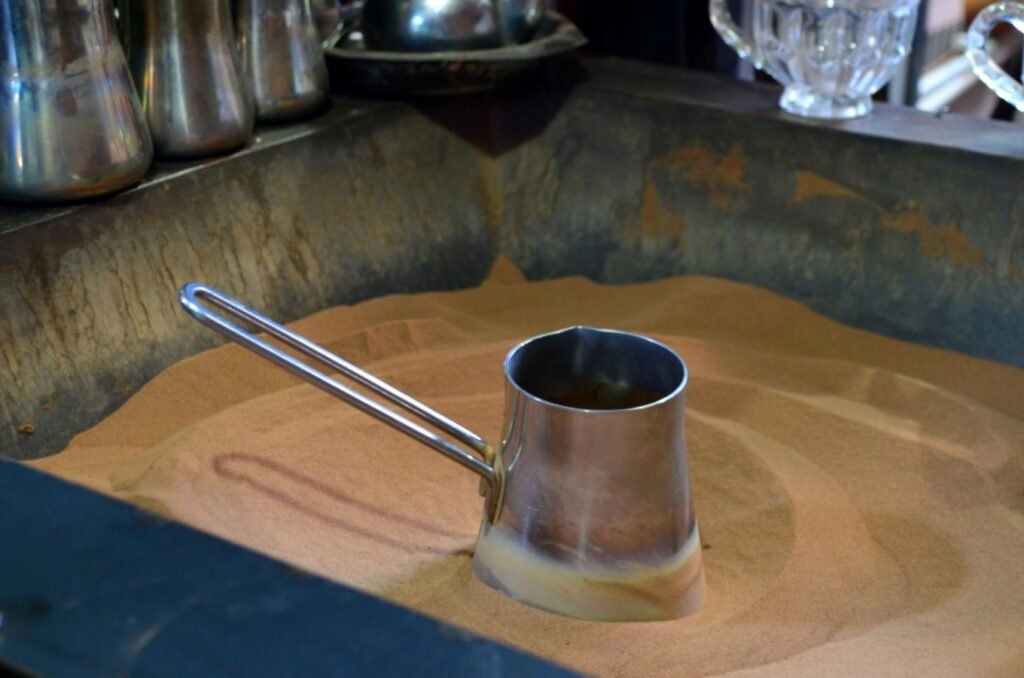
In addition to exploring the old city on foot, visitors can also enjoy a leisurely ride through Marrakech in a horse-drawn carriage. These carriages are a distinctive symbol of the city, showcasing the exceptional skills and composure of the drivers. Maneuvering horses through the often chaotic traffic requires not only expertise but also great patience and agility.
Our carriage driver shared with us that his family owns four horses, with two horses working as a team while the others rest on alternating days. However, unlike the horses, he himself works every day—a demanding routine that left us with a deep appreciation for his dedication.

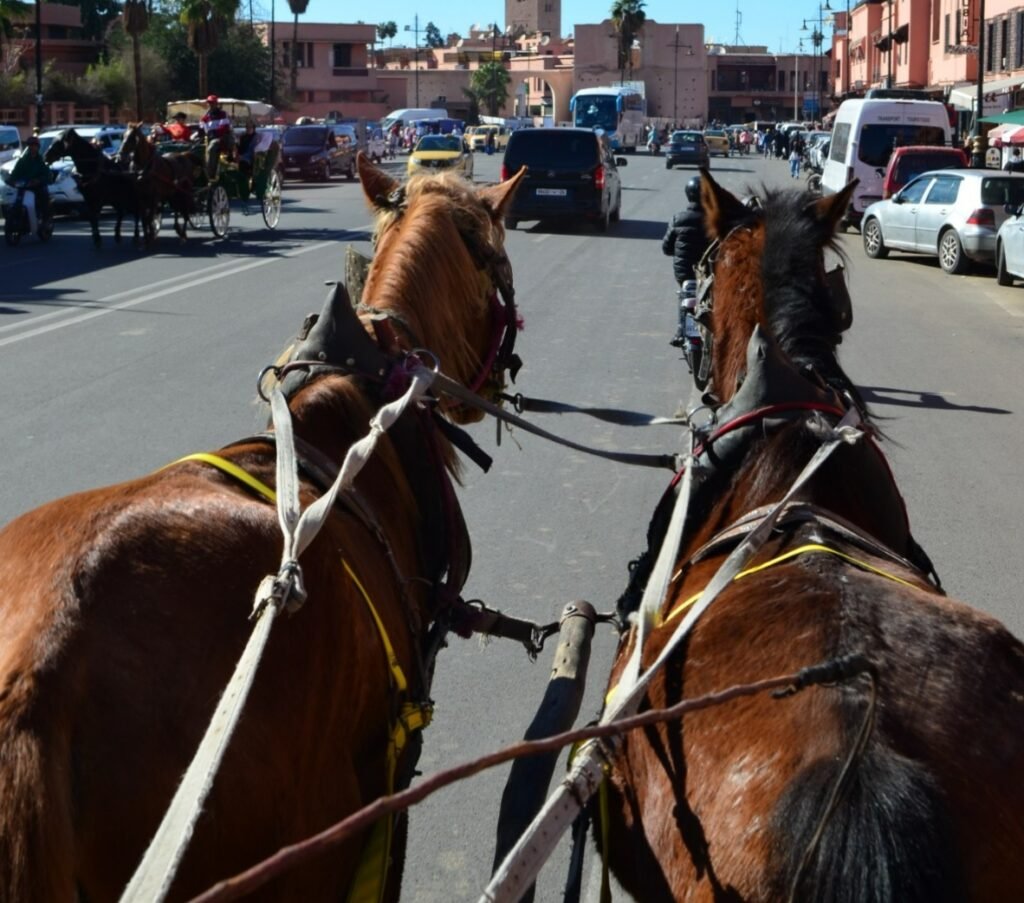
Travel Tips (Non-Commercial Recommendations):
- Drone Use: Drones are prohibited throughout Morocco; do not bring them through customs.
- SIM Cards: At Marrakech airport, free SIM cards are available upon presenting your passport, with options to top up as needed.
- Weather: Be prepared for occasional high temperatures during the day; bring sunscreen and essential medications.
- Getting Around Medina: Most attractions are located within the Medina. If you get lost in the alleys, ask nearby shopkeepers for directions.
- Jemaa el-Fna Square: While browsing the many stalls, always agree on prices in advance, regardless of how friendly the vendors may seem. Avoid photographing people or stalls without permission to prevent misunderstandings. Also, keep your belongings secure.
- Entry to Majorelle Garden and YSL Museum: Tickets must be booked online in advance; entry is not possible without a reservation.
- Local Customs: Morocco is relatively conservative, so it’s advisable to respect local customs and dress modestly.
- Secret Garden: Visiting the Secret Garden is not highly recommended as it offers limited value for its price.

